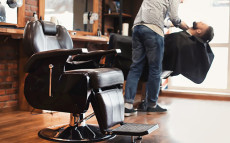- pathfindersAI
- Job Profile
Barbers
Summary
Barbers: Crafting Style and Confidence
What They Do
Barbers are skilled professionals in the personal care industry who specialize in cutting, trimming, styling, and shaving hair and beards. Their work extends beyond mere haircutting; they are artists who sculpt and shape hair to enhance their clients' aesthetic appeal and self-confidence. Barbers master various techniques and tools to cater to diverse hair types and style preferences, ensuring every client leaves the chair looking well-groomed and satisfied.
Job Responsibilities
The daily responsibilities of barbers encompass a broad spectrum of tasks. Primarily, barbers cut, trim, and style hair using an array of tools such as scissors, clippers, razors, and trimmers. They are adept at performing close shaves and intricate beard styling, requiring precision and a steady hand. Additionally, barbers consult with clients to understand their desired outcomes, recommend suitable styles, and offer professional advice on hair care. They maintain their tools and workstations to uphold cleanliness and safety standards and manage appointments and customer service duties. Participation in continuous professional development is also vital, as it helps barbers stay abreast of the latest trends and techniques in haircare and grooming.
Essential Skills
To excel as a barber, one must possess a blend of technical and interpersonal skills. Technical skills include proficiency in various haircutting and styling techniques, knowledge of hair types, and expertise in using different barbering tools. Precision and attention to detail are crucial for delivering high-quality results consistently. Interpersonal skills are equally important as barbers need to build rapport with clients, understand their preferences, and provide excellent customer service. Effective communication, patience, and a friendly demeanor contribute significantly to client satisfaction and repeat business.
Educational Pathways
Becoming a barber involves a structured educational pathway that includes formal training and certification. Individuals typically enroll in barber schools or cosmetology programs that offer specialized courses in haircutting, styling, shaving, and sanitation. These programs combine classroom instruction with hands-on training, allowing students to practice their skills under the supervision of experienced instructors. Upon completing these programs, aspiring barbers must pass a state licensing examination, which assesses their theoretical knowledge and practical abilities. Continuing education is often required to maintain licensure and keep up with emerging trends and techniques in the industry.
Career Prospects
The career prospects for barbers are promising, particularly for those who continually refine their skills and stay updated with industry trends. Barbers can find employment in various settings, including barbershops, salons, spas, and even luxury hotels and resorts. Many barbers choose to become entrepreneurs by opening their own barbershops, which allows for greater income potential and creative freedom. The demand for skilled barbers remains steady, driven by the perennial need for grooming services and the growing trend of men's grooming and self-care. Additionally, experienced barbers can explore roles as educators or trainers in barber schools, or even transition into product development or sales within the haircare industry.
Conclusion
In essence, the profession of barbering is a blend of artistry, precision, and interpersonal skill. Barbers play a vital role in helping individuals present their best selves to the world, thus gaining a sense of confidence and well-being. The journey to becoming a professional barber involves dedicated training and a commitment to lifelong learning. With favorable career prospects and a diverse range of opportunities, barbering offers a fulfilling and dynamic career for those passionate about the art of hair styling and grooming.
Barbering is not just a job; it is a craft that combines technical skill with creative expression, and it holds the potential for personal and professional growth. Whether working in an established barbershop or venturing into entrepreneurship, barbers have a significant impact on the communities they serve, making it a rewarding career choice for many.
Video
Compensation
| State | Median Salary | Median Hourly | Positions |
|---|---|---|---|
| HI | 29,470 | 14.17 | 70 |
| AL | 27,110 | 13.04 | 140 |
| AR | 30,220 | 14.53 | 120 |
| CA | 35,970 | 17.29 | 1,500 |
| CO | 36,820 | 17.70 | 430 |
| CT | 39,040 | 18.77 | 90 |
| FL | 34,960 | 16.81 | 760 |
| GA | 35,570 | 17.10 | 520 |
| IL | 35,310 | 16.98 | 380 |
| IN | 47,810 | 22.98 | 340 |
| IA | 39,260 | 18.88 | 160 |
| MD | 36,150 | 17.38 | 100 |
| MS | 22,190 | 10.67 | 80 |
| MO | 43,430 | 20.88 | 500 |
| NJ | 38,910 | 18.71 | 1,370 |
| NY | 49,420 | 23.76 | 1,370 |
| NC | 47,290 | 22.73 | 140 |
| ND | 33,280 | 16.00 | 140 |
| OK | 23,600 | 11.34 | 110 |
| PA | 40,490 | 19.47 | 880 |
| SC | 36,740 | 17.66 | 420 |
| TN | 29,710 | 14.28 | 310 |
| TX | 36,670 | 17.63 | 2,670 |
| UT | 24,960 | 12.00 | 330 |
| VA | 37,550 | 18.05 | 350 |
| WA | 57,980 | 27.88 | 660 |
| WV | 33,040 | 15.89 | 90 |
| WI | 34,360 | 16.52 | 390 |
Similar Occupations
In this area you will find other occupations that are close to the one you were viewing in tasks, knowledge and work environment. If the primary job profile you are viewing isn't quite to your liking, take a look around and see what else is available.
Basic and Premium Accounts have more alternative occupations available than the Free account.

First-Line Supervisors of Personal Service Workers - 39-1022.00
First-Line Supervisors of Personal Service Workers oversee and coordinate the activities of staff engaged in providing personal services, such as childcare, housekeeping, or fitness training. They ensure quality service standards are upheld, manage schedules, train employees, and handle customer or client complaints to maintain efficient service operations.
-
$46,690/yr
Median Pay -
106,440
Number of Jobs

Hairdressers, Hairstylists, and Cosmetologists - 39-5012.00
Hairdressers, hairstylists, and cosmetologists specialize in enhancing clients' appearance through cutting, coloring, and styling hair, as well as providing skincare, nail care, and makeup services. They also consult with clients to recommend styles and treatments that best suit their needs and preferences.
-
$34,970/yr
Median Pay -
294,840
Number of Jobs